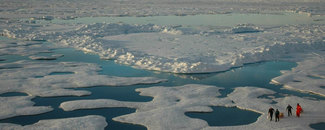New study suggests climate models may underestimate rate of melting

Arctic sea ice has important implications for coastal environments, economic development, and global weather patterns. And the ice is melting rapidly. Measurements last year revealed the second lowest extent of Arctic sea ice on record, and NOAA scientists and colleagues expect the melting to accelerate in coming decades.
Now a new paper in the journal Climate suggests that the Arctic may be essentially ice-free during summer within fifteen years.
That projection, however, comes with a caveat. In the paper, scientists from the North Carolina Institute for Climate Studies (NCICS), NCEI, NOAA Pacific Marine Environmental Laboratory, and the University of Washington evaluate climate models by comparing their performance to satellite observations of rates of melting in recent years. The results indicate that there is room for improvement in sea-ice models—and that the ice may disappear even more quickly than current models suggest.
Ice Matters
Every year, the Arctic sea ice cap expands and thickens during winter and then shrinks and thins during summer. In recent decades, increasing temperatures have caused rapid reductions in ice extent in all seasons, but especially at the end of summer.
What scientists refer to as the first ice-free Arctic summer year (FIASY) will occur when the Arctic has less than one million square kilometers of sea ice. (The thick ice sheets surrounding Canada’s Arctic islands are likely to remain for much longer, even in summer.)
At the end of summer 2019, the extent of Arctic sea ice measured 4.15 million square kilometers, tying 2007 and 2016 for the second lowest since modern record keeping began in the late 1970s. NOAA tracks ice and other environmental issues on an annual Arctic Report Card.
The extent of Arctic ice is important to Arctic peoples, whose lands are being affected by increased coastal erosion. Conversely, the disappearance of ice creates economic opportunities, including the opening of oil fields and new shipping routes. National security could also be affected.
The extent of Arctic sea ice also has important implications for ocean currents, as well as regional and global weather patterns.
Models of Melting
In the Climate paper, lead author Ge Peng of NCICS and colleagues used twelve climate models to simulate and project the extent of Arctic sea ice under two different emissions scenarios. The scenarios represent midrange (RCP4.5) and high (RCP8.5) projections for the volume of greenhouse gases that will be emitted into the atmosphere in coming decades.
Under the midrange emissions scenario, the twelve climate models settled on 2054 as the likely first ice-free Arctic summer. Under the high emissions scenario, the models suggested it could happen in 2042.
Both of those years represent averages of projections made by the twelve models. Projections of the first ice-free summer varied widely depending on the model and scenario used. One model projected an ice-free summer as early as 2023, although the authors describe that possibility as “unrealistic.” In another model the ice-free threshold was not reached until after 2100.
The new study’s projected dates of a first ice-free summer in the 2040s or 2050s are somewhat later than those from an earlier study by Peng and colleagues, which relied on projections based on extrapolations of observed data, projecting a date in the 2030s.
One set of projections from the new paper, however, conformed more closely to those from the earlier study. Predictions using statistical models applied to the first thirty years of climate projections (2006–2035) suggested that the Arctic could be ice-free in the decade 2030–2040, with the year 2034 as the most likely.
The satellite observations suggest that Arctic sea ice depletion is accelerating, while the climate model projections generally show a linear, rather than accelerating, rate of decline. That implies that “climate models may be collectively underestimating the rate of change,” the authors write. “Therefore, one can argue that there is still room for improvement for the sea ice sub-models within the global climate model systems.”



